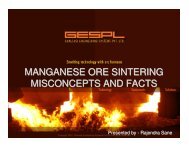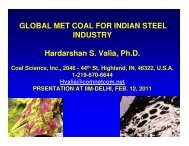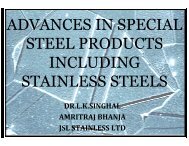Role of Engineers & Technologists in Sustainable Development - IIM
Role of Engineers & Technologists in Sustainable Development - IIM
Role of Engineers & Technologists in Sustainable Development - IIM
You also want an ePaper? Increase the reach of your titles
YUMPU automatically turns print PDFs into web optimized ePapers that Google loves.
Dr. Sanak Mishra<br />
Chairman, International Organisation <strong>of</strong> Materials,<br />
Metals and M<strong>in</strong>erals Societies (IOMMMS)<br />
CEO, Greenfield Projects India, ArcelorMittal
What is Susta<strong>in</strong>ability<br />
Derived from Lat<strong>in</strong> word ‘Sust<strong>in</strong>ere’,<br />
mean<strong>in</strong>g ‘to hold’<br />
The Brundtland Commission, United<br />
Nations, March 20, 1987: “Susta<strong>in</strong>able<br />
development is development that meets the<br />
needs <strong>of</strong> the present without compromis<strong>in</strong>g<br />
the ability <strong>of</strong> future generations to meet<br />
their own needs”
Three Pillars <strong>of</strong> Susta<strong>in</strong>ability<br />
United Nations 2005 World Summit, New York:<br />
Susta<strong>in</strong>ability def<strong>in</strong>ed <strong>in</strong> terms <strong>of</strong> three pillars <strong>of</strong><br />
susta<strong>in</strong>ability. These three pillars, <strong>of</strong>ten, overlap<br />
each other and can have a synergistic effect on<br />
each other
Three Pillars <strong>of</strong> Susta<strong>in</strong>ability (1/3)<br />
Environmental Susta<strong>in</strong>ability<br />
Operations consume resources from<br />
environment and provide some output and<br />
waste material to this environment<br />
Natural resources are limited
Three Pillars <strong>of</strong> Susta<strong>in</strong>ability (2/3)<br />
Economic Susta<strong>in</strong>ability<br />
Income generation for a group, based on optimal<br />
utilization <strong>of</strong> a set <strong>of</strong> resources<br />
When an eco-system and the operat<strong>in</strong>g<br />
environment are disturbed from their equilibrium<br />
position, the connected economic activity takes a<br />
hit as well<br />
Average per capita consumption <strong>in</strong> develop<strong>in</strong>g<br />
world can be susta<strong>in</strong>able <strong>in</strong> view <strong>of</strong> exist<strong>in</strong>g<br />
natural resources, but only by ma<strong>in</strong>ta<strong>in</strong><strong>in</strong>g<br />
environmental equilibrium
Three Pillars <strong>of</strong> Susta<strong>in</strong>ability (3/3)<br />
Social Susta<strong>in</strong>ability<br />
Any operation has to closely deal with the locals<br />
<strong>in</strong>volved and needs to overcome the local<br />
challenges<br />
Social Susta<strong>in</strong>ability deals with issues perta<strong>in</strong><strong>in</strong>g<br />
to the health, education and other such factors<br />
perta<strong>in</strong><strong>in</strong>g to the local society <strong>in</strong> general<br />
Imperative for the authorities to take necessary<br />
action for preserv<strong>in</strong>g the cultural values and local<br />
diversity
Impact <strong>of</strong> aspirations for a better<br />
quality <strong>of</strong> life<br />
People are used to a certa<strong>in</strong><br />
way <strong>of</strong> life <strong>in</strong> developed<br />
economies<br />
May not be an optimum way <strong>of</strong><br />
utiliz<strong>in</strong>g the natural resources<br />
At times, may lead to wasteful<br />
consumption <strong>of</strong> resources and<br />
energy<br />
Much <strong>of</strong> this lifestyle relies<br />
heavily on the non-renewable<br />
resources<br />
To susta<strong>in</strong> such a lifestyle<br />
seems unsusta<strong>in</strong>able <strong>in</strong> the<br />
long run
A Truly Susta<strong>in</strong>able Society<br />
We should also add a<br />
fourth pillar to the three<br />
exist<strong>in</strong>g pillars <strong>in</strong> the<br />
def<strong>in</strong>ition <strong>of</strong><br />
Susta<strong>in</strong>ability<br />
Susta<strong>in</strong>ability<br />
Because the aspiration<br />
to atta<strong>in</strong>, very quickly, a<br />
“better quality <strong>of</strong> life”,<br />
<strong>of</strong>ten shortchanges the<br />
foundations <strong>of</strong> ETHICS
<strong>Role</strong> <strong>of</strong> <strong>Eng<strong>in</strong>eers</strong> and<br />
<strong>Technologists</strong> <strong>in</strong> Society (1/2)<br />
Progress <strong>of</strong> any economy and its<br />
technological viability is measured by the<br />
“Innovations” activity <strong>in</strong> the country.<br />
For progressive economic growth and social<br />
development, technology is <strong>of</strong>ten called<br />
upon to redef<strong>in</strong>e, restructure and<br />
reorganize our technological and physical<br />
environment<br />
<strong>Eng<strong>in</strong>eers</strong> form a sort <strong>of</strong> <strong>in</strong>terface between<br />
the operations team and the end customer.
<strong>Role</strong> <strong>of</strong> <strong>Eng<strong>in</strong>eers</strong> and<br />
<strong>Technologists</strong> <strong>in</strong> Society (2/2)<br />
<strong>Eng<strong>in</strong>eers</strong> & <strong>Technologists</strong> are engaged <strong>in</strong>:<br />
Conceptualization and Design<strong>in</strong>g and<br />
adapt<strong>in</strong>g them to their applications <strong>in</strong><br />
<strong>in</strong>dustry and <strong>in</strong>frastructure<br />
Production <strong>of</strong> goods and services, at<br />
optimum costs, and <strong>of</strong>fer<strong>in</strong>g wide choices<br />
there<strong>in</strong><br />
Promot<strong>in</strong>g technologies and services to<br />
<strong>in</strong>crease public comfort and welfare; and<br />
thereby better<strong>in</strong>g their Quality <strong>of</strong> Life
The World Federation <strong>of</strong> Eng<strong>in</strong>eer<strong>in</strong>g<br />
Organisations (WFEO) held a meet<strong>in</strong>g <strong>in</strong><br />
September 1991 <strong>of</strong> its General Assembly <strong>in</strong><br />
Arusha, Tanzania. At this meet<strong>in</strong>g WFEO<br />
adopted the Arusha Declaration on the<br />
future role <strong>of</strong> eng<strong>in</strong>eer<strong>in</strong>g, developed from a<br />
study <strong>of</strong> Our Common Future, (the report<br />
<strong>of</strong> the World Commission on Environment<br />
and <strong>Development</strong>)
World Federation <strong>of</strong> Eng<strong>in</strong>eer<strong>in</strong>g<br />
Organisations Model Code <strong>of</strong> Ethics, 2001<br />
As population and economic growth place<br />
<strong>in</strong>creas<strong>in</strong>g pressures on our social and<br />
biophysical environment, eng<strong>in</strong>eers must<br />
accept <strong>in</strong>creased responsibilities to develop<br />
susta<strong>in</strong>able solutions to meet community<br />
needs, overcome extreme poverty and prevent<br />
segregation <strong>of</strong> people. The education <strong>of</strong><br />
eng<strong>in</strong>eers needs to <strong>in</strong>culcate an<br />
understand<strong>in</strong>g <strong>of</strong> susta<strong>in</strong>ability and cultural<br />
and social sensitivities as well. The<br />
eng<strong>in</strong>eer<strong>in</strong>g code <strong>of</strong> ethics must reflect a<br />
strong commitment to pr<strong>in</strong>ciples <strong>of</strong><br />
susta<strong>in</strong>able development.
<strong>Role</strong> <strong>of</strong> <strong>Eng<strong>in</strong>eers</strong> <strong>in</strong> mitigation <strong>of</strong> negative<br />
impacts <strong>of</strong> Industrial <strong>Development</strong> (1/3)<br />
Through more energy efficient and<br />
least, or <strong>in</strong>ferior, raw material<br />
demand<strong>in</strong>g technologies<br />
By suggest<strong>in</strong>g better materials to<br />
reduce volume and weight<br />
requirements<br />
Develop<strong>in</strong>g <strong>in</strong>novative design and<br />
eng<strong>in</strong>eer<strong>in</strong>g for longer life cycle
<strong>Role</strong> <strong>of</strong> <strong>Eng<strong>in</strong>eers</strong> <strong>in</strong> mitigation <strong>of</strong> negative<br />
impacts <strong>of</strong> Industrial <strong>Development</strong> (2/3)<br />
One essential feature <strong>of</strong> Kyoto Protocol that<br />
has direct relevance to the role <strong>of</strong> eng<strong>in</strong>eers<br />
and technologists is the requirement that<br />
countries limit, or, reduce their greenhouse<br />
gas emissions.<br />
CDM (Clean <strong>Development</strong> Mechanism) allows<br />
emission-reduction projects <strong>in</strong> develop<strong>in</strong>g<br />
countries to earn certified emission reduction<br />
(CER) credits which can be traded/sold.<br />
<strong>Eng<strong>in</strong>eers</strong> can help <strong>in</strong> development <strong>of</strong> “Green”<br />
plants for lesser CO2 emissions.
<strong>Role</strong> <strong>of</strong> <strong>Eng<strong>in</strong>eers</strong> <strong>in</strong> mitigation <strong>of</strong> negative<br />
impacts <strong>of</strong> Industrial <strong>Development</strong> (3/3)<br />
Another area where eng<strong>in</strong>eers and<br />
technologists can make significant<br />
contribution is towards:<br />
“Green Chemistry”, which works<br />
on the pr<strong>in</strong>ciple that “it is better to<br />
prevent waste than to treat or clean<br />
up waste after it is formed”
NATIONAL ACTION PLAN ON CLIMATE CHANGE
The Way Forward:<br />
Eight National Missions<br />
National Solar Mission<br />
National Mission on Enhanced Energy Efficiency<br />
National Mission on Susta<strong>in</strong>able Habitat<br />
National Water Mission<br />
National Mission for Susta<strong>in</strong><strong>in</strong>g Himalayan<br />
Ecosystem<br />
National Mission for a Green India<br />
National Mission for Susta<strong>in</strong>able Agriculture<br />
National Mission on Strategic Knowledge for<br />
Climate Change
Some Initiatives <strong>in</strong> India (1/3)<br />
National Solar Mission<br />
The government plans to generate 20,000 MW solar power<br />
by 2022 under the three-phase National Solar Mission,<br />
with 2000 MW capacity equivalent <strong>of</strong>f-grid solar<br />
applications, <strong>in</strong>clud<strong>in</strong>g 20 million solar lights, also<br />
planned to be <strong>in</strong>stalled dur<strong>in</strong>g this period.<br />
Clean Energy and Technology<br />
The Energy Efficiency Indicator (EEI) survey for corporate<br />
India, released <strong>in</strong> June 2009, reveals that 47 per cent <strong>of</strong> the<br />
respondents are pay<strong>in</strong>g more attention to energy<br />
efficiency, compared to 2008 and 94 per cent <strong>of</strong> the<br />
respondents feel that energy management is extremely<br />
important.
Some Initiatives <strong>in</strong> India (2/3)<br />
CII Climate Change Center<br />
Established with the objective <strong>of</strong> spread<strong>in</strong>g awareness <strong>of</strong><br />
climate change issues <strong>in</strong> the Indian Industry<br />
Greenhouse Gas Pollution Prevention Project-<br />
Climate Change Supplement<br />
Organised jo<strong>in</strong>tly by CII, <strong>Development</strong> Alternatives, ICICI,<br />
and Lal Bahadur Shastri National Academy <strong>of</strong><br />
Adm<strong>in</strong>istration; the program aims to create a forum for<br />
greater dialogue and technical cooperation on global<br />
climate change and clean energy issues between US and<br />
Indian Government.
Some Initiatives <strong>in</strong> India (3/3)<br />
The Indian Renewable Energy<br />
<strong>Development</strong> Agency Ltd (IREDA), Power<br />
F<strong>in</strong>ance Corporation, SIDBI, PTC India Ltd<br />
and HSBC India have come together to<br />
develop an energy efficiency <strong>in</strong>vestment<br />
market <strong>in</strong> India, as they jo<strong>in</strong> the Bureau <strong>of</strong><br />
Energy Efficiency's (BEE) proposed<br />
f<strong>in</strong>anc<strong>in</strong>g platform.
Environment<br />
and the<br />
Steel Industry
A quick look at development<br />
through years<br />
21
National Steel Policy – 2005<br />
Production Imports Exports Consumption<br />
2019-20 110 6 26 90<br />
2004-05 38 2 4 36<br />
Compounded<br />
Annual<br />
Growth Rate<br />
7.3% 7.1% 13.3% 6.9%<br />
NSP Projections for Production, Imports,<br />
Exports and Consumption <strong>of</strong> Steel (MT)<br />
22
Some Growth Parameters <strong>in</strong> India<br />
Source: Bus<strong>in</strong>ess Monitor<br />
International 23 study, July-Sep 2010
Fundamentals <strong>of</strong> Steel Industry <strong>in</strong> India<br />
India<br />
24
Over 90% <strong>of</strong> CO2 emission <strong>in</strong> steel<br />
mak<strong>in</strong>g is on account <strong>of</strong> energy<br />
consumption. Therefore the energy<br />
sav<strong>in</strong>g is the most important<br />
approach to reduce CO2 emission.<br />
25<br />
WorldCO2 emission <strong>of</strong> iron and steel<br />
<strong>in</strong>dustry accounts for 6% <strong>of</strong> world’s<br />
total.<br />
Ch<strong>in</strong>a: In 2008, CO2 emission <strong>of</strong> iron<br />
and steel <strong>in</strong>dustry accounted for 15.6%<br />
<strong>of</strong> Ch<strong>in</strong>a’s s total.
Rapid development <strong>of</strong> Ch<strong>in</strong>a's s Iron & Steel<br />
IndustryCh<strong>in</strong>a<br />
Ch<strong>in</strong>a's s crude steel output has ranked No.1<br />
<strong>in</strong> the world for 13 years, which accounted for 15.4%<br />
and 46.4% <strong>of</strong> world's total <strong>in</strong> 2000 and 2009,<br />
respectively.<br />
26<br />
SourceWorld Steel Association
Emissions (CO2), 2030<br />
27
Ma<strong>in</strong> measures <strong>of</strong> iron and steel <strong>in</strong>dustry to<br />
save energy and reduce CO2 emission<br />
Innovative manufactur<strong>in</strong>g technologies to realize the<br />
energy conservation and emission reduction <strong>in</strong> steel<br />
mak<strong>in</strong>g.<br />
Innovation steel materials to support the energy<br />
conservation and emission reduction <strong>of</strong> downstream<br />
<strong>in</strong>dustries.<br />
28
Over the past 30 years, global steelmakers have<br />
made remarkable improvement <strong>in</strong> reduc<strong>in</strong>g energy<br />
consumption: In such developed areas as North<br />
AmericaJapan<br />
JapanEurope, etc, with<strong>in</strong> the 30 years<br />
from 1975 to 2005, average energy consumption per<br />
ton <strong>of</strong> steel has decreased by about 50.<br />
SourceIISI, AISI, JISF, and JFE (2008)<br />
“Global Steel Sectoral Approach”<br />
29
2005<br />
4.0<br />
3.5<br />
3.0<br />
2.5<br />
2.0<br />
1.5<br />
1.0<br />
0.5<br />
0.0<br />
30<br />
1950<br />
1955<br />
1960<br />
1965<br />
1970<br />
1975<br />
1980<br />
1985<br />
1990<br />
1995<br />
2000<br />
coke oil coal<br />
CO2 emission (t CO2 / t HM) *
Great achievements have been made <strong>in</strong> energy<br />
conservation and emission reduction <strong>of</strong> Ch<strong>in</strong>a's steel<br />
<strong>in</strong>dustry over the past 30 years<br />
Standard coal consumption per ton <strong>of</strong> steel: 2.04 tons <strong>in</strong> 1980,<br />
0.62 tons <strong>in</strong> 2009; reduced by nearly 70%.<br />
CO2 emission per ton <strong>of</strong> steel: 3.22 tons <strong>in</strong> 1991, 1.87 tons <strong>in</strong> 2007, 2<br />
reduced by 42%.<br />
31
Innovation <strong>in</strong> the techniques <strong>of</strong> steel mak<strong>in</strong>g<br />
also play a critical role on energy<br />
conservation and emission reduction.<br />
Example: Improvement <strong>in</strong> the cast<strong>in</strong>g<br />
techniques leads to a great energy sav<strong>in</strong>g.<br />
Mould<br />
Cast<strong>in</strong>g<br />
Cont<strong>in</strong>uous<br />
Cast<strong>in</strong>g<br />
Th<strong>in</strong> Slab<br />
Cast<strong>in</strong>g<br />
Strip<br />
Cast<strong>in</strong>g<br />
32
Case Study – Reduction <strong>of</strong> direct CO 2<br />
emission by Steel Industry (1/3)<br />
AISI- In North America AISI sponsors a number<br />
<strong>of</strong> university programs, that cover among<br />
others,<br />
Gas-Solid Suspension Iron mak<strong>in</strong>g<br />
Technology based on hydrogen reduction<br />
Technical Feasibility <strong>of</strong> Steelmak<strong>in</strong>g by<br />
Molten Oxide Electrolysis<br />
Australian program- The Australian national<br />
program focuses on the use <strong>of</strong> bio-mass as a<br />
substitute to coal.
Case Study – Reduction <strong>of</strong> direct CO 2<br />
emission by Steel Industry (2/3)<br />
Bao Steel program <strong>in</strong> Ch<strong>in</strong>a focusses on Energy<br />
sav<strong>in</strong>g projects. Bao steel is also member <strong>of</strong> CO 2<br />
breakthrough program<br />
JISF CO 2 Taskforce program <strong>in</strong> Japan for JFE,<br />
NSC, Sumitomo and Kobe explores two<br />
<strong>in</strong>terest<strong>in</strong>g avenues:<br />
Reduction <strong>of</strong> CO 2 emissions from Blast<br />
Furnaces<br />
Capture <strong>of</strong> CO 2 from Blast Furnace gas:<br />
chemical and physical absorption to capture,<br />
separate and recover CO 2
Case Study – Reduction <strong>of</strong> direct CO 2<br />
emission by Steel Industry (3/3)<br />
The Shougang plant with its environnemental<br />
management systems is a benchmark model for greenfield<br />
sites demonstrat<strong>in</strong>g the ambition <strong>in</strong> terms <strong>of</strong> energy<br />
efficiency and m<strong>in</strong>imisation <strong>of</strong> resources <strong>in</strong> production<br />
process.<br />
Posco CO 2 project look<strong>in</strong>g at captur<strong>in</strong>g the CO 2 with<br />
subsequent storage from the FINEX process. The program<br />
uses Hydrogen Steelmak<strong>in</strong>g with Iron ore reduction <strong>of</strong><br />
FINEX us<strong>in</strong>g hydrogen-enriched syngas.<br />
Ch<strong>in</strong>a Steel Corporation <strong>in</strong> Taiwan is develop<strong>in</strong>g<br />
solutions on CO 2 captur<strong>in</strong>g technologies (<strong>in</strong>clud<strong>in</strong>g<br />
adsorption, absorption, etc.) <strong>in</strong> reheat<strong>in</strong>g furnaces
ULCOS PROGRAM<br />
The ULCOS Program started <strong>in</strong> 2004, br<strong>in</strong>g<strong>in</strong>g together 48<br />
partners <strong>in</strong> Europe with a budget <strong>of</strong> 75 M€ with<br />
ArcelorMittal as the leader. It is one <strong>of</strong> the most ambitious,<br />
with objective <strong>of</strong> steel production emission reduction <strong>in</strong> the<br />
range <strong>of</strong> 30-70%. Of all the technologies studies by ULCOS<br />
the Top Gas Recycl<strong>in</strong>g (TGR) coupled with Carbon Capture &<br />
Storage (CCS) is the most immediately promis<strong>in</strong>g route.<br />
ULCOS is presently mov<strong>in</strong>g <strong>in</strong>to the f<strong>in</strong>al stage <strong>of</strong> the<br />
scale up <strong>of</strong> the Top-Gas Recycl<strong>in</strong>g Blast Furnace<br />
technology to commercial size. This second-step<br />
Demonstration <strong>in</strong>itiative is called ULCOS II. The next<br />
phase <strong>of</strong> the project will <strong>in</strong>clude a pilot step focused on<br />
demonstrat<strong>in</strong>g the capture part <strong>of</strong> the technology and a<br />
demonstrator step where the capture will be scaled up to<br />
the size <strong>of</strong> an average EU blast furnace<br />
36
Output <strong>of</strong> auto(×10<br />
4 )<br />
Fuel Economy <strong>of</strong> Automobile & High Strength Steel<br />
<br />
Ch<strong>in</strong>a Automobile: Over the past 10 yearsCh<strong>in</strong>a's automobile <strong>in</strong>dustry<br />
has been rapidly developed. In 2010, sales volume <strong>of</strong> Ch<strong>in</strong>a automobile<br />
obile<br />
market expects to exceed 17 million.<br />
Oil Consumption: Recently automobile accounts for 1/3 <strong>of</strong> total oil o<br />
consumption <strong>in</strong> Ch<strong>in</strong>a, and is estimated to rise to 57<strong>in</strong> 2020<br />
Provid<strong>in</strong>g the material solution to automotive lightweight<br />
weight<strong>in</strong>g <strong>in</strong>g is<br />
significant to low carbon society.<br />
1800<br />
1600<br />
1400<br />
1200<br />
1000<br />
800<br />
600<br />
400<br />
200<br />
0<br />
1991<br />
1992<br />
1993<br />
1994<br />
1995<br />
1996<br />
1997<br />
1998<br />
1999<br />
2000<br />
2001<br />
2002<br />
Time(year)<br />
<br />
2003<br />
2004<br />
2005<br />
2006<br />
2007<br />
2008<br />
2009<br />
2010<br />
37
Fuel Economy <strong>of</strong> Automobile & High Strength Steel<br />
The technical solution to energy sav<strong>in</strong>g <strong>of</strong><br />
automobile is weight-lighten<strong>in</strong>g, s<strong>in</strong>ce each 10%<br />
weight los<strong>in</strong>g could reduce 37% 3<br />
fuel consumption<br />
and 13% CO 2<br />
emission.<br />
38
Fuel Economy <strong>of</strong> Automobile & High Strength Steel<br />
Steel solution to automotive lightweighti<br />
weight<strong>in</strong>g: : application <strong>of</strong> HSS. R&D <strong>of</strong><br />
new generation AHSS with better comprehensive properties.<br />
In 2009, the application proportion <strong>of</strong> HSS <strong>in</strong> Ch<strong>in</strong>ese automobile <strong>in</strong>dustry<br />
was only about 25<br />
while that value abroad was over 50.<br />
EL (%)<br />
70<br />
60<br />
50<br />
40<br />
30<br />
20<br />
10<br />
3th<br />
3th<br />
Generation<br />
AHSS<br />
AHSS<br />
IF<br />
HSSIF<br />
Mild HSSIF<br />
IS<br />
BH<br />
CMn<br />
TRIP<br />
DP<br />
HSLA<br />
TWIP<br />
Aust. ss<br />
0<br />
200 400 600 800 1000 1200<br />
TS (MPa(<br />
)<br />
2nd<br />
2nd<br />
Generation<br />
AHSS<br />
AHSS<br />
TWIP<br />
Q&P<br />
MART/CP<br />
1400<br />
HS<br />
1600<br />
1st 1st Generation<br />
Generation<br />
AHSS<br />
AHSS<br />
Ratio <strong>of</strong> HSS(%)<br />
30.0<br />
25.0<br />
20.0<br />
15.0<br />
10.0<br />
5.0<br />
0.0<br />
2002 2004 2006 2008 2010<br />
Time(year)<br />
Average ratio <strong>of</strong> HSS <strong>in</strong> Ch<strong>in</strong>ese automobile<br />
39
Oil/gas transportation & pipel<strong>in</strong>e steels with<br />
high strength and high toughness<br />
40
41<br />
Energy Efficiency <strong>of</strong> Power Plant Boiler Tubes (Ch<strong>in</strong>a)<br />
Material researchers should make greater efforts to develop<br />
more competitive steel material with higher hightemperature<br />
strength and higher oxidation resistance to<br />
improve the thermal efficiency <strong>of</strong> power plants.
Ultra High<br />
Strength<br />
Steel<br />
1500m<br />
High Strength Steel<br />
750m<br />
Wrought Iron<br />
300m<br />
Construction <strong>of</strong> high-rise Eiffel tower with high strength steel.
Thank You
















